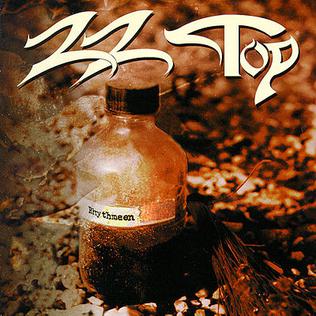Top Qs
Timeline
Chat
Perspective
Rhythmeen
1996 studio album by ZZ Top From Wikipedia, the free encyclopedia
Remove ads
Rhythmeen is the twelfth studio album by the American rock band ZZ Top, released in 1996. It is their last album with longtime producer Bill Ham.
This article needs additional citations for verification. (June 2012) |
Remove ads
Production and recording
Billy recalls "Rick Rubin has turned me on to one of his acts called Barkmarket and that the guitar player uses C# and B tunings so we began experimenting with really low tunings."[3] Around the Rhythmeen era Billy's collection of African artifacts began and several tracks include African tribal percussion.
This is when Billy began to sport the Nudu Hat, woven by the Bamileke tribe in Cameroon, Africa.
Gibbons uses a 1955 Les Paul Goldtop guitar which is featured prominently throughout the album.[4]
"We originally had a working title of 'Nearing the Completion Stage'. But, it was the backbeat, that mean groove, which hit us as a strong recurring element of the album. So, we did our customary play on words, shuffling words about until we came up with our own invention—a feel-good elixir named Rhythmeen."[5]
Remove ads
Reception
AllMusic gave it a mixed review, stating, "ZZ Top's long-awaited return to blues finally arrived in 1996, well over a decade after they abandoned their simple three-chord boogie for a synth and drum machine-driven three-chord boogie."[1]
The album peaked at number 29 on the Billboard 200 and at number 32 on the UK Albums Chart.
Remove ads
Track listing
- Bonus track [Japan]
Personnel
- Billy Gibbons – guitar, lead vocals
- Dusty Hill – bass, keyboards, backing vocals, lead vocals (10)
- Frank Beard – drums, percussion
- James Harman – harmonica (4)
- Greg Morrow – percussion, drums (credited[9] as 'Gangzz Clangzz & Percussion Thangzz') on "She's Just Killing Me" [10] and other tracks[11]
Production
- Producers – Billy Gibbons, Bill Ham
- Engineer – Joe Hardy
- Assistant engineers – Lizzie Harrah, Gary Moon
- Mixing – Joe Hardy
- Mastering – Bob Ludwig
- Director – Douglas Biro
- Art direction – Sean Mosher-Smith
- Design – Billy Gibbons, Sean Mosher-Smith
- Photography – James Bland
- Studio – John Moran's House of Funk aka Digital Services Recording
Charts
Album – Billboard (United States)
Singles – Billboard (United States)
Remove ads
References
Wikiwand - on
Seamless Wikipedia browsing. On steroids.
Remove ads

